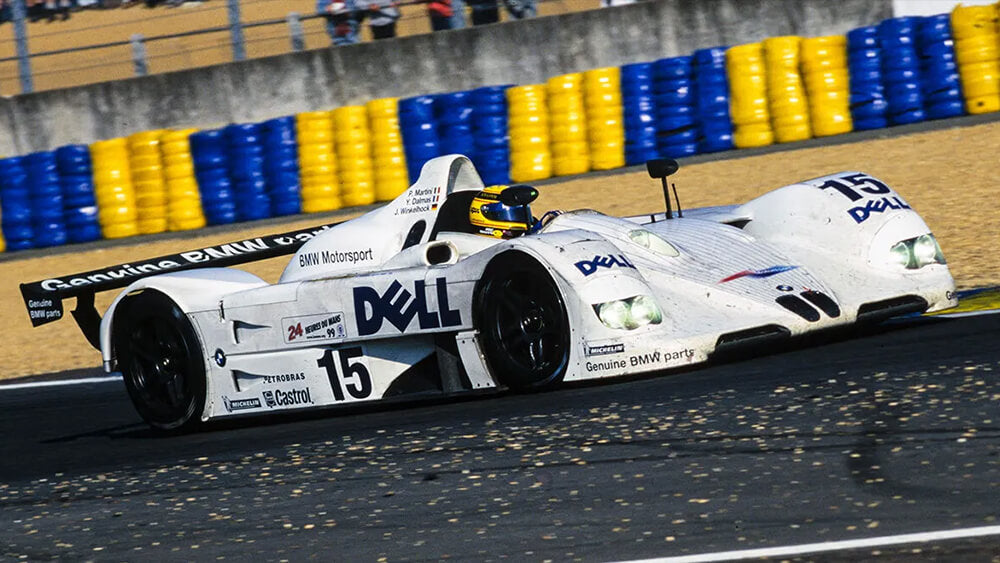24h Le Mans Centenary: 1993-2002 | Written by Richard Kelley
The 67th Le Mans 24 Hours was the strongest ever in terms of factory participation. Five of the world’s biggest automobile manufacturers – BMW, Daimlerchrysler, Nissan, Toyota and Vag – entered powerful works teams.
It was also one of the most dramatic races in the history of the famous 24-hour event; as a Mercedes flew off into the trees lining the circuit, a Toyota challenging for the lead burst a tyre at over 300 km/h on the main straight in the final hour and, almost unnoticed, the svelte BMW V12 LMR scored the Bavarian company’s only victory at this epic race.
The all-new BMW V12 LMR chassis arrived at Le Mans having inherited only 68 components from a total of 3500 in the company’s 1998 original exploratory car. The most immediately noticeable new feature of the 1999 model was its single-seater style roll hoop.
The anomaly in the ACO’s rules allowing this approach had been spotted as early as April 1998, albeit too late for inclusion in the design of that year’s model.
Although it made the car look radically different, the effect of the single roll hoop on aerodynamic efficiency was small, amounting to a reduction in drag of just a few pounds. However, the configuration did allow the adoption of a ‘sidecar’ layout, with one side of the car higher than the other, significantly improving airflow to the low-mounted rear wing.
This ‘sidecar’ layout was further accentuated by the design of the engine air collector box, the inlet for which was now located alongside the driver on the righthand side of the car.
The V12 LMR was fitted with a dual overhead cam 48-valve engine with 5990.50cc displacement and 580 horsepower at 6500 RPM and an estimated speed of 220 miles-per-hour.
 Pierluigi Martini / Yannick Dalmas / Joachim Winkelhock, BMW V12 LMR, crossing the finish line during the 1999 24h Le Mans. Image Courtesy: Motorsport Images.
Pierluigi Martini / Yannick Dalmas / Joachim Winkelhock, BMW V12 LMR, crossing the finish line during the 1999 24h Le Mans. Image Courtesy: Motorsport Images.
In testing, it had swiftly become clear that the two new BMW V12 LMR sports prototypes could exploit the crucial advantage of superior fuel consumption relative to all the opposition. Their pace was similar to that of the race favourites – the Toyotas – but the BMW drivers could run one lap more on each shift or run the same number of laps and take on less fuel.
The race got off to a fast start; the competition was instantly hot. For the first few hours, the #6 Mercedes, driven by Bernd Schneider and #1 & 2 Toyotas, driven by Martin Brundle and Thierry Boutsen, fought at the front. The #17 BMW was just a short length behind and used its superior fuel economy to take the lead.
At approximately 8 pm, the #5 Mercedes was fighting with the #2 Toyota for second place at about 8 pm when AMG’s purpose-designed Mercedes CLR underwent terrifying backward somersaults after cresting high-speed brows in the aerodynamic wake of other cars. Mercedes immediately withdrew its remaining cars.
Martin Brundle’s #1 Toyota suffered a high-speed puncture on the Mulsanne straight; the crash badly damaged his car’s rear suspension, and he was unable (despite his best efforts) to return to the pits.
The #2 Toyota driven by Thierry Boutsen was next to go when he suffered a high-speed crash under the Dunlop bridge. The impact destroyed the car, and Boutsen injured his lower back. When the second Toyota crashed out, BMW Motorsport ran 1-2, which seemed set to maintain until the chequered flag.
 Pierluigi Martini / Yannick Dalmas / Joachim Winkelhock, BMW V12 LMR, in high speeds during the 1999 24h Le Mans. Image Courtesy: Motorsport Images.
Pierluigi Martini / Yannick Dalmas / Joachim Winkelhock, BMW V12 LMR, in high speeds during the 1999 24h Le Mans. Image Courtesy: Motorsport Images.
By dawn, the #17 BMW was four laps in front of its sister #15 BMW; it looked like nothing could spoil their triumph. However, at approximately 10 am, with JJ Lehto driving #17 BMW, a detached anti-roll bar suddenly jammed open the throttle.
The #17 snapped sideways and crashed in the Porsche curves, destroying the front of the car. After spending over 18 hours in the lead, a tiny piece of metal had robbed #17 of victory.
Now the fight between BMW and Toyota was down to one car each. To their credit, the Japanese came back into the picture with some determined driving, and the Toyota pit believed that they would catch BMW before the 4 pm finish. BMW Motorsport, however, was running its car within its performance limits and was ready to respond.
The #15 BMW was positioned almost a lap ahead of the #3 Toyota, quietly cruising at a steady pace. With this sniff of a win, Ukyo Katayama put his boot into the Toyota and set the race's fastest lap.
Just into the final hour, Katayama narrowed the gap to less than a minute when an inattentive backmarker forced his Toyota onto a kerb. After two more corners, the left rear tyre blew, and his challenge ended. Ukyo was, however, able to return to the pits for new tyres and continued.
However, by then, bar any problems for the BMW, the race was out of reach. Audi came in a respectable 3rd at their first attempt at Le Mans, setting them up nicely for the subsequent domination.
The "end of the century' was the last race for several "big" manufacturers. Only Audi would return for 2000.
Follow the link below to read more stories from the 100 years of 24h Le Mans and discover our celebratory poster collection in cooperation with the Automobile Club de l'Ouest.














































